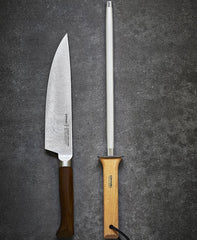Maintaining a knife blade is essential to ensure a quality edge and the safest use— a dull edge is more dangerous than a sharp-edged blade. Regularly assailed by the food it cuts and the ceramic of the plates, it is important to sharpen your kitchen cutlery like you would sharpen a used pocket knife. Master all you need to know about knife sharpening, learn about the different tools and see the techniques used to sharpen knives in the kitchen or in your pocket.
When should you sharpen your knife?

Trust your instincts. If the knife chops more than it cuts, it is time to sharpen it. Although there is no perfect rule, we recommend sharpening regularly to ensure the knife has the best possible edge.
Sharpening can also happen before or after its use. Sometimes, when cutting food, you may find that the cutting edge needs to be sharpened. Instead of waiting wipe your knife down, sharpen it, and wipe it once more again before continuing to cook. The knife should always be clean when sharpening so as not to leave residue on the tool.
What types of knives can be sharpened?

Caution not all knives can be sharpened. This is the case with serrated knives, bread knives and peelers. It is important to take care unique blades after frequent use to preserve their cutting edge. Knives with a smooth blade can be sharpened including: kitchen, table, garden, kids and pocket knives.
Knives made from Stainless-Steel and Carbon Steel blades can both be sharpened with our tools. However, Carbon Steel is softer, is easier to sharpen and will require fewer passes.
What are the different sharpening tools?
First up, there are the sharpening rods, available in steel and diamond.
The diamond rod is used for knives that have a worn, damaged cutting edge that needs to be reshaped. It has small points that give it more abrasive properties.
The steel rod is used more for regular sharpening of knives and maintenance. It has longitudinal lines that you can feel when touched. It is magnetized, which allows the filings to stay on the rod and not on the knife after sharpening.
In addition to our sharpening tools we also offer sharpening stones and a compact manual sharpener. The manual sharpener is our easiest to use. Simply pass the knife 6 to 8 times between the two plates, without applying too much pressure, point down. In order to remove the metal particles that remain on the edge of the blade after sharpening, pass it 4 or 5 times with the tip of the knife upwards.


What are the different sharpening techniques?

There are 2 sharpening techniques for rods, whether they are steel or diamond.
The first is that taught in cooking schools. This technique is best to also use a cutting board underneath the rod to prevent damage on the sharpening surface. We recommend placing the end of the rod in the groove in order to stabilise it. The rod should be in an upright position, held firmly. There should be an angle of approximately 20° between the blade and the rod. Slowly, sharpen the knife following the cutting edge, from the bottom of the blade to the tip. This movement can be performed 6-8 times on both sides of the blade.
The second technique is used more commonly by butchers. With this technique, the rod is not placed, it is held by the hand horizontally. Always with an angle of 20°, perform the same movement, following the cutting edge of the knife to the point in a measured manner. To practice safe sharpening, move the knife away rather than towards you.
Both of these techniques are suitable for kitchen knives, table knives and even folding knives. For beginners, we recommend trying the first technique for sharpening with extra stability. To prevent damaging the cutting edge be careful not to press too hard and follow sharpening at a 20° angle.


How do you maintain a rod?
A rod doesn't require a lot of maintenance. After each use, just wipe it off with a clean cloth to remove the remaining filings. Do not grease the rod. This actually dulls the abrasiveness and can cause the knives to slip when sharpening.
Opinel rods are fitted with lace at the end of the handle which allows them to be hung up. They are also the right size to be stored in drawer with other utensils.
